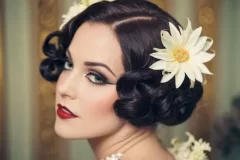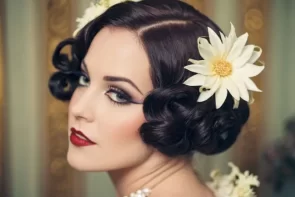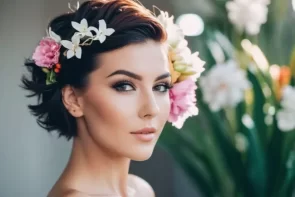10 Timeless 1920S Hairstyles That Define The Roaring Twenties
The 1920s, also known as the Roaring Twenties, was a decade of change and revolution, especially in the world of fashion and beauty. It was a time when women were gaining independence, and their hairstyles reflected this new sense of freedom. From short bobs to glamorous finger waves, the hairstyles of the 1920s were bold, elegant, and timeless. In this article, we'll explore 10 iconic hairstyles that define the decade, highlighting the details that made them so unforgettable. Whether you’re looking for inspiration for a themed party or just want to know more about the fashion of the era, these styles are worth learning about!
1. Classic Bob
One of the most iconic hairstyles of the 1920s is the classic bob. This short haircut, usually cut straight around the jawline, was a symbol of women’s liberation from traditional long locks. The bob was sleek, simple, and versatile, often paired with a side part for added sophistication. The ends were often slightly curled under for a soft finish.
Ideal Inspiration: Louise Brooks, a famous silent film actress, was known for her chic and sharp bob.
2. Finger Waves
Finger waves are synonymous with the glamour of the 1920s. This hairstyle involves sculpting the hair into “S” shaped waves using the fingers and a comb, then setting it with gel or hair lotion. The result is a glossy, smooth wave pattern that hugs the scalp closely. Finger waves were often seen on both short and medium-length hair.
Ideal Inspiration: Josephine Baker, the legendary entertainer, was known for her stunning finger waves.
3. Eton Crop
The Eton crop is a daringly short haircut that became popular in the late 1920s. It’s a boyish cut, very close to the scalp, with a soft wave at the front. This hairstyle gave women a chic, rebellious look, perfect for those who wanted to challenge traditional beauty standards. It required minimal maintenance, making it ideal for the modern woman of the time.
Ideal Inspiration: Colleen Moore, a major film star of the 1920s, was famous for her Eton crop.
4. Marcel Waves
Marcel waves are similar to finger waves but were created using a special heated iron known as a Marcel iron. This hairstyle featured deep waves that added volume and elegance, making it a popular choice for evening events. Marcel waves could be styled in shorter bobs or longer styles, giving a romantic yet polished look.
Ideal Inspiration: Gloria Swanson, a star of silent films, frequently wore glamorous Marcel waves.
5. Shingle Bob
The shingle bob is a variation of the classic bob, characterized by a tapered nape. The back of the hair is cut shorter and layered, allowing it to hug the neck closely. The shingle bob was often paired with a center or side part and was worn sleek or with soft waves for a sophisticated finish.
Ideal Inspiration: Clara Bow, known as the "It Girl" of the 1920s, often sported a stylish shingle bob.
6. Curly Flapper Bob
The curly flapper bob adds a playful twist to the classic bob style. This version features loose, bouncy curls that give the hair more texture and volume. The curls were usually styled with a finger wave pattern at the front, adding a hint of glamor. This style was perfect for dancing the night away in the jazz clubs of the era.
Ideal Inspiration: Anita Page, a famous actress during the 1920s, was often seen with a curly flapper bob.
7. Faux Bob
For women who didn’t want to commit to a full chop, the faux bob was a clever alternative. Hair was pinned up at the nape to create the illusion of a shorter length while maintaining long locks. It was a popular hairstyle for elegant evening occasions, as it allowed women to switch between long and short styles easily.
Ideal Inspiration: Greta Garbo, the glamorous film star, often styled her long hair into a faux bob.
8. Short Spit Curls
Spit curls were a defining feature of 1920s fashion, where small sections of hair were curled into tight ringlets that framed the face. These curls added a delicate and playful touch to any hairstyle, often seen alongside bobs, finger waves, and shingle cuts. They were especially popular among the young flappers of the time.
Ideal Inspiration: Pola Negri, a Polish actress and singer, was known for her signature spit curls.
9. Pageboy Bob
The pageboy bob was another variation of the bob, featuring hair that was slightly longer, usually cut to chin or shoulder length, with the ends curled under. This gave a rounded, smooth look that framed the face beautifully. It was often worn with a deep side part and paired with a jeweled headband or hair accessory.
Ideal Inspiration: F. Scott Fitzgerald's wife, Zelda Fitzgerald, was a trendsetter for this hairstyle.
10. Cloche Hat Hairstyle
The cloche hat was a popular accessory in the 1920s, and hairstyles were often designed to complement its snug fit. Women would style their hair close to the scalp, usually with finger waves or a short bob, so that it could be tucked neatly under the hat without losing its shape. This look was both practical and stylish, embodying the spirit of the decade.
Ideal Inspiration: Myrna Loy, a famous actress of the time, frequently wore her hair in styles suitable for the fashionable cloche hat.
Comments



 Save
Save




























